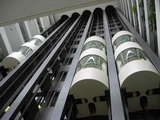Bed Elevators
Patient care in hospitals often requires transporting the patient up and down to various floors in the hospital for various treatments and diagnostic tests. Oftentimes patients could potentially be contagious which would put the general public at risk if they were to be transported on public elevators. The reverse can also be true. Sometimes the patient's health is compromised enough that the slightest bacterial or viral infection could be lethal. For this reason, hospitals have special bed elevators for moving patients up and down levels within the facility. Also, most bed elevators are built with longer depths to facilitate the length of hospital beds.
Hospital Stretcher Lift
Usually smaller than bed elevators but still in the same category are hospital stretcher lifts. This particular type of elevator is usually hydraulic or traction based depending on the location of the machine room. They are specifically manufactured to be low-noise bed elevators that smoothly transport patients, doctors, nurses and hospital staff between floors, allowing them the utmost in comfort. Because hospital bed elevators are only used for transporting patients and hospital staff they arrived at their location quite quickly, eliminating lengthy waits. Many of these bed elevators are key operated so as to prohibit use by the general public. The minimum size for this type of lift is usually 3' x 7' and can service literally any number of floors.
Hospital Bed Elevators
Hospital bed elevators generally transport patients who are not well enough to sit up even in a wheelchair. Perhaps they are not even alert such as after major surgery or being in a coma. One of the features of bed elevators should be its ability to transport the patient has smoothly as possible with minimal amount of bumping and jostling. Bed elevators are usually designed to stop and start without jerking the patient around which also provides for safety as well as comfort. Many contemporary bed elevators are manufactured to consume extremely low amounts of power and to be durable with a number of safety features built-in. Hospital bed elevators generally draw very little power so that should there be a power outage they are still operational off the hospital's backup power supply. Most often there will be a rear and a front entry to the elevator cabin.
Bed elevators are specifically manufactured with patient care in mind. The dimensions of bed elevators are specifically important because the hospital staff moving the bed about will need room for maneuverability. Bed elevators are heavy duty industrial caliber elevators that are specifically manufactured to be durable, safe and smooth. Because at elevators are not used by the general public, they are usually situated in an area of the hospital where visitors are not likely to traverse. Also, bed elevators are designed for function not decor so they are generally less decorative but easier to sanitize. There are a number of manufacturers that specialize in bed elevators, many of them with the capability of building bed elevators to custom specifications.

